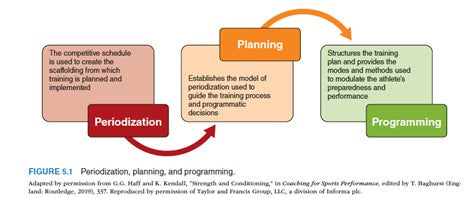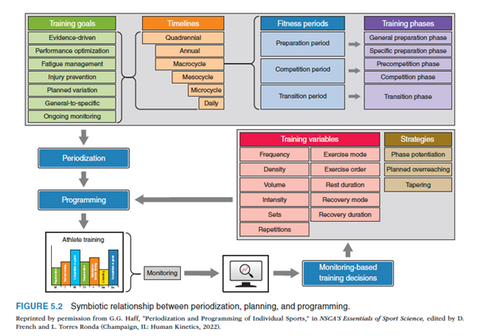The idea that training practices need to be systematically organized is not a new or novel concept. In fact, historic evidence dating back more than 2,000 years reveals that ancient thinkers discussed many of the precursors of periodization (3, 10, 11). Even though periodization has a rich history and offers coaches and sports scientists an organizational framework to guide the training process, several modern sport scientists and coaches have scrutinized this construct (1, 2, 4, 5, 12-15). At the center of this debate is confusion about what periodization is, how it differs from planning and programming, and the role monitoring plays.
Defining Periodization
Even though periodization is considered a critical tool for managing the training process, to date there is no universally accepted definition of the concept. The lack of a commonly accepted definition likely contributes to much of the confusion surrounding periodization (7, 16). Periodization should be considered a scaffolding framework around which training is planned and programming decisions are made to address the athlete’s specific needs. Conceptually, periodization could be considered a cyclical approach to training, where periodic changes to the training process are implemented in order to elevate performance capacity at appropriate time points. When informed by an integrated monitoring program, the process of periodization allows for the delivery of modifiable training activities to be guided by the athlete’s responses to the applied training activities.
Therefore, periodization should be defined as “a cyclical training approach in which the logical integration of modifiable training parameters (i.e., volume, intensity, training density, training frequency, exercise selection, and mode) are planned to optimize the athlete’s performance at appropriate times.”
Periodization, Planning, and Programming
One of the central factors surrounding much of the confusion about periodization is that it is often confused with planning and programming. These terms, while interrelated, are not interchangeable and should not be considered as such.

Periodization is a macromanagement strategy that provides a framework that is used to guide the training process. It is used to forecast and assign periods of time to the development of specific attributes and targets. This is accomplished by establishing individualized training objectives that are aligned with specific training cycles (e.g., multiyear training plans, annual training plans, macrocycles, mesocycles, and microcycles) and based on the athlete’s individual needs. It provides the coach with a blueprint that can be used to plan the training models that will be used to direct loading patterns and guide the overall training process (8, 9). Based on the micromanagement decisions made at the periodization level and the decisions made at the planning level, the coach can construct the training program.

The construction of the training program is centered on the prescription of the modes and methods of training that are used to deliver the training stimulus required to stimulate the adaptive responses required to achieve the targeted performance goals.
Periodization and Monitoring
A central aspect of a well-structured periodized training plan is the integration of a monitoring program. In fact, monitoring is considered a critical part of periodization because it allows the coach to determine whether the athlete is responding as planned to the training process (6). Central to this process is monitoring the athlete’s internal load (i.e., response to the applied training stimulus), the external training load (i.e., the applied training stimulus) that the athlete is exposed to, and the training outcomes (specifically the athlete’s performance).

Ultimately, the coach can use the data garnered from the monitoring process to make informed decisions about how best to modify the training process at the programming level.
References
- Afonso, J, Nikolaidis, PT, Sousa, P, and Mesquita, I. Is empirical research on periodization trustworthy? A comprehensive review of conceptual and methodological issues. J Sports Sci Med 16:27-34, 2017.
- Afonso, J, Rocha, T, Nikolaidis, PT, Clemente, FM, Rosemann, T, and Knechtle, B. A systematic review of meta-analyses comparing periodized and non-periodized exercise programs: Why we should go back to original research. Front Physiol 10:1023, 2019.
- Bompa, TO, and Haff, GG. Annual training plan. In Periodization: Theory and Methodology of Training. 5th ed. Champaign, IL: Human Kinetics, 125-185, 2009.
- Buckner, SL, Jessee, MB, Mouser, JG, Dankel, SJ, Mattocks, KT, Bell, ZW, Abe, T, and Loenneke, JP. The basics of training for muscle size and strength: A brief review on the theory. Med Sci Sports Exerc 52:645-653, 2020.
- Connolly, F, and White, P. The evolution of preparation. In Game Changer. Canada: Victory Belt Publishing, 247-264, 2017.
- DeWeese, BH, Gray, HS, Sams, ML, Scruggs, SK, and Serrano, AJ. Revising the definition of periodization: Merging historical principles with modern concerns. Olympic Coach Magazine 24:5-19, 2015.
- Haff, GG. The essentials of periodisation. In Strength and Conditioning for Sports Performance. Jeffreys, I, and Moody, J, eds. Abingdon, Oxon: Routledge, 404-448, 2016.
- Haff, GG. Periodization and programming of individual sports. In NSCA’s Essentials of Sport Science. French, D, and Torres Ronda, L, eds. Champaign, IL: Human Kinetics, 27-42, 2022.
- Haff, GG, and Kendall, K. Strength and conditioning. In Coaching for Sports Performance. Baghurst, T, ed. England: Routledge, 310-350, 2019.
- Issurin, V. Periodization training from ancient precursors to structured block models. Kinesiol Int J Fundam Appl Kinesiol 46:3-9, 2014.
- Issurin, VB. New horizons for the methodology and physiology of training periodization. Sports Med 40:189-206, 2010.
- Kiely, J. New horizons for the methodology and physiology of training periodization: Block periodization: New horizon or a false dawn? Sports Med 40:803-805, 2010.
- Kiely, J. Periodization paradigms in the 21st century: Evidence-led or tradition-driven? Int J Sports Physiol Perform 7:242-250, 2012.
- Kiely, J. Periodization theory: Confronting an inconvenient truth. Sports Med 48:753-764, 2018.
- Mattocks, KT, Dankel, SJ, Buckner, SL, Jessee, MB, Counts, BR, Mouser, JG, Laurentino, GC, and Loenneke, JP. Periodization: What is it good for? Journal of Trainology 5:6-12, 2016.
- Verkhoshansky, Y, and Verkhoshansky, N. The contribution of Yuri Verkhoshansky to the development of sport science. In Special Strength Training Manual for Coaches. Rome, Italy: Verkhoshansky SSTM, 263-284, 2011.
Learn more in Scientific Foundations and Practical Applications of Periodization.


